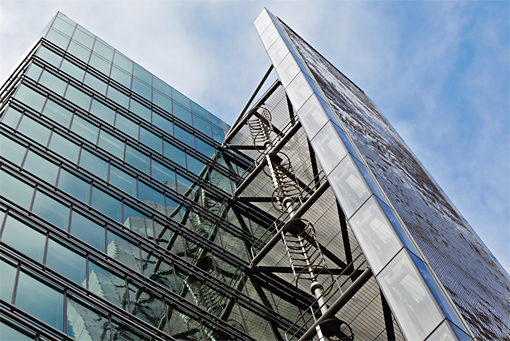| 제목 | [DAIKIN] GOVERNMENT - San Francisco Public Utilities Commission Headqu… | 작성일 | 16-06-16 14:17 |
| 글쓴이 | 최고관리자 | 조회수 | 5,303 |
본문
CASE STUDY
Office Building
Name
San Francisco Public Utilities Commission headquarters
Location
San Francisco, CA USA
Facility Size
13-story Class A office building; 277,500 ft2
Issue
Highly sustainable office building needed innovative HVAC efficiency
Solution
Daikin Magnitude® magnetic bearing chillers
Daikin chillers help put the "green" in North America's greenest office building
The San Francisco Public Utilities Commission (SFPUC) headquarters in downtown San Francisco at 525 Golden Gate—called "the greenest office building in North America"—opened in July 2012 to widespread acclaim for its sustainability and energy savings. Compared to similar 13-story office buildings, 525 Golden Gate produces 50 percent less of a carbon footprint and uses 32 percent less energy and 60 percent less water.
The SFPUC headquarters houses more than 900 employees and includes a data center in the lower level, a childcare center and café. For ratepayers, the SFPUC estimates that building and owning its new headquarters will allow the department to save local residents around $3.7 billion ($500 million in 2012 dollars) over the expected 100-year life of the building.
Sustainability Summary compared to a similarly sized building

Carbon footprint
50% less
Annual energy consumption
32% less
Water usage
60% less
Solar and wind power, high efficiency mechanical systems, natural ventilation and daylight harvesting all contribute to the remarkable energy savings at 525 Golden Gate. The exterior of the sleek 13-story building uses roof-mounted solar arrays and wind turbines which can generate up to 7% of the building's energy needs. On the interior, additional shading devices control glare and minimize heat gain while light shelves facilitate daylight harvesting. Lighting and work station equipment shut off automatically after hours. SFPUC's goal was to be an example for building smart, efficient and sustainable buildings in response to the dwindling natural resources, said Masoud Vafaei, SFPUC's Project Engineer.
Complexity demanded teamwork
The scope of the SFPUC building project entailed an exacting design and construction process. Nial Keeling, P.E., project engineer for heating, ventilating, and air conditioning (HVAC) with ACCO Engineering Systems in San Leandro, California, the mechanical contractor on the project, said the project's complexity demanded great teamwork and relied on building information modeling (BIM). "This was not a standard job. The sheer volume of paperwork involved in this job, including owner-directed changes and RFIs (requests for information), was huge due to the complexity of the systems. Everyone on the team worked well together."
SJ Engineers of San Francisco, California, provided the mechanical engineering including HVAC, plumbing and fire protection at 525 Golden Gate. Any chillers selected for the building's HVAC system had to meet extreme efficiency requirements in order to meet the design goal of LEED Platinum certification. "An analysis had to be made in non-biased conditions to determine the type of efficiencies each chiller manufacturer could achieve," said Kreyne Sato, principal engineer at SJ Engineers.

On the interior of the building, shading devices control glare and minimize heat gain while light shelves facilitate daylight harvesting.
After factory certified testing to AHRI (Air Conditioning, Heating & Refrigeration Institute) Standard 550/590 for water cooled chillers, two Daikin Magnitude chillers were selected—one 500-ton and one 250- ton unit. With their magnetic-bearing oil-less compressors and integral variable frequency drives, these chillers are 40 percent more energy efficient than traditional centrifugal compressor chillers. In addition to their efficiency, the compact footprint, weight, and electrical service of the Daikin chillers were factors in their selection, according to Sato.
The performance of the Magnitude chillers allows the building to satisfy every operating condition efficiently, especially at part load which occurs frequently in the mild San Francisco climate. "There's always demand for cooling in this building. You have the data center in the lower level and other areas that require cooling every day," said Ron Yaffe, senior sales engineer at Norman S. Wright Mechanical Equipment Inc., representatives for Daikin in the San Francisco area.
Traditional mechanical system with a modern twist
The building's HVAC system design is based on a traditional four-pipe system and includes the two chillers, two rooftop cooling towers for the chilled water system, two large variable air volume (VAV) custom air handling units, heat exchangers, and an underfloor air-distribution system that conserves building space and minimizes ductwork and uses personal control of airflow. "The chillers are inherently efficient," says Alex Brown, senior engineer with SJ Engineers. "In addition, we also included other efficiency features such as a chilled water economizer that goes into the system which allows the chillers to ramp down to their minimum capacity before shut off."
The building's underfloor air-distribution system (also known as a raised floor plenum) accommodates data lines and most of the ventilation infrastructure including air handling equipment, as well as linear and swirl diffusers in the floor supply air for cooling. The building envelope includes operable windows which occupants can control. If a window is opened, the building automation system shuts off the flow of conditioned air through the underfloor system to the corresponding zone.
The advanced underfloor system serves to reduce heating, cooling and ventilation costs by more than fifty percent. Overhead areas accommodate return air booths. "From a service point of view, it's very practical for equipment to be accessed with fewer restrictions than overhead placement allows," Nial Keeling said.
HVAC installation and commissioning
Following initial planning in 2007, ground was broken at 525 Golden Gate in spring 2008 and construction commenced in fall 2009. The Daikin chillers were delivered in June 2011 and hoisted by crane onto the building's roof-top area mechanical room—before all roof construction was completed. The approximately 10'×30' mechanical room comprises a partial fourteenth floor above the thirteenth-floor offices.
"The rigging requirements included setting the chillers in place and anchoring them down based on the seismic data as calculated and signed off by the structural engineers and architect," Keeling says. "The chillers had to be anchored to undertake a seismic event and isolate the vibration between the chillers and the building." The Daikin chillers themselves are also seismic compliant to International Building Code (IBC) standards and the California Office of Statewide Health Planning and Development (OSHPD) pre-approval.
The mechanical room opens out into a rooftop which houses the cooling towers and air handling units. Boston-based energy management firm EnerNOC provided MEP design review and managed the building commissioning process.
Exceeding standards
With all the efficiency measures, the building's design exceeds ASHRAE 90.1 requirements for energy efficiency for heating and cooling in new office buildings by an impressive 51 percent. "It's very unusual to see a large, high-rise public project like this push the envelope of energy efficiency and sustainability in so many ways. The project is a testament to the City of San Francisco's level of commitment to protecting our resources, while providing a comfortable and enjoyable work environment," says Mike Rubio, senior vice president at Norman S. Wright Mechanical Equipment.
Building intelligence
Sunbelt Controls, Inc. of San Leandro, California, provided the controls design and installation. Doug Johnson, project manager with Sunbelt Controls, said the BACnet® protocol built into the Automated Logic Corporation building automation system was selected to control the building HVAC equipment, based on the project owner's requirement for open communication protocols and database compliance. "The Automated Logic system is native BACnet, allowing all the HVACrelated information—including the plumbing and fuel oil system—to be easily accessible to the building's comprehensive Integrated Building Management System, known as the IBMS," Johnson said. The Open Choices® feature of the Magnitude chillers allowed for easy integration with the building control systems using BACnet communications.
From the building elevators to the waste water treatment system, to solar and wind systems, the extensive IBMS monitors and helps to manage approximately 13,500 data points collected from every building system including the mechanical direct digital controls. "The IBMS designed by SmartBuildings and developed by ControlCo provides a holistic window to all building systems and their interactions giving the building operators a single system for managing this complex building" Said Masoud Vafaei.
Beyond building materials
Recycled building materials and high efficiency mechanical systems, are just two aspects of sustainability at 525 Golden Gate, SFPUC headquarters. An on-site grey and black water treatment technology called the Living Machine® reclaims and treats all of the waste water from the building to meet the demand for the building's restrooms. The Living Machine can treat 5,000 gallons of water daily, reducing per-person water use from 12 to five gallons. A rainwater harvesting system, with the capacity to store up to 25,000 gallons of water annually for use by the exterior irrigation system, serves living gardens. Limited vehicle parking and on-site bicycle parking encourage alternative transportation among employees.
Public enthusiasm
Starting with public tours of the facility in June that quickly reached capacity, the SFPUC building has generated widespread enthusiasm from San Francisco residents. The SFPUC still encourages self-guided tours of the building lobby where visitors can view the digital arts wall and read about the sustainability and architectural innovations of 525 Golden Gate.
The Daikin chillers are doing their part by operating smoothly and quietly. "The new chillers are extremely quiet," says Mark Lawn, chief engineer for the SFPUC building. "And that's important because the chillers are located in the space directly above the executive offices on the 13th floor."
About the San Francisco Public Utilities Commission
The San Francisco Public Utilities Commission (SFPUC) is a department of the City and County of San Francisco that provides retail drinking water for San Francisco, wholesale water for three other Bay Area counties, wastewater services for San Francisco and green hydroelectric, solar and biogas power for San Francisco's municipal departments.

The exterior of the 13-story building uses integrated hybrid solar array and wind turbines which can generate up to 7% of the building's energy needs.
| 이전글 | [DAIKIN] GOVERNMENT - Queen Creek Library 2016-06-16 | ||
| 다음글 | [DAIKIN] GOVERNMENT - Saratoga-Bradenton International Airport 2016-06-16 | ||






